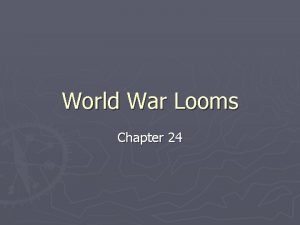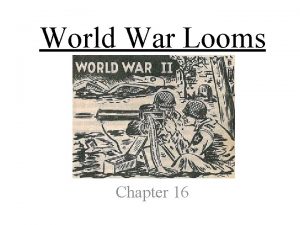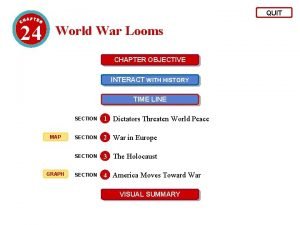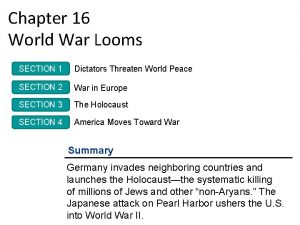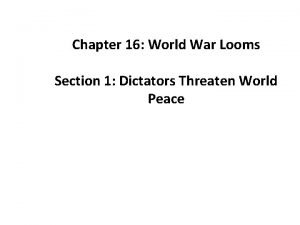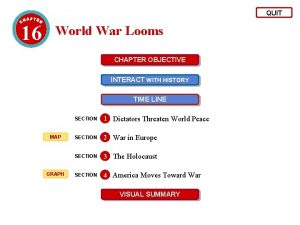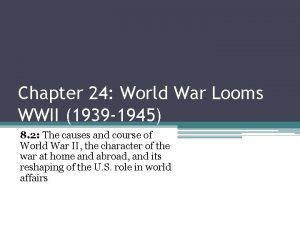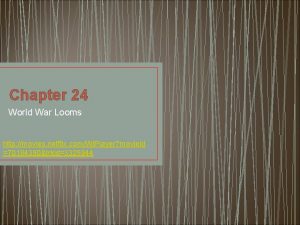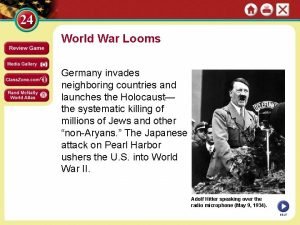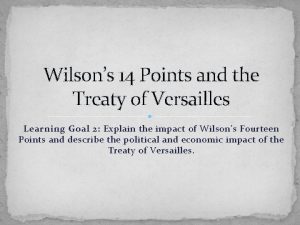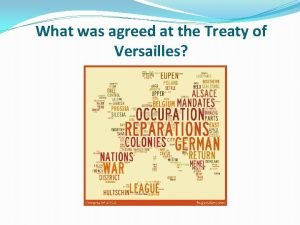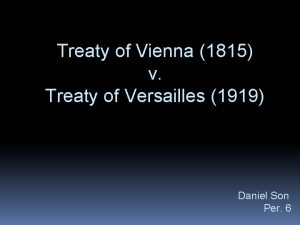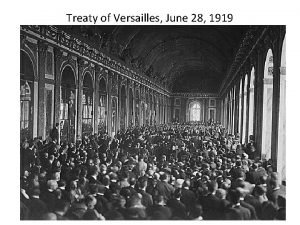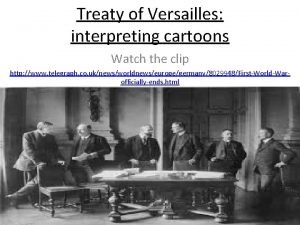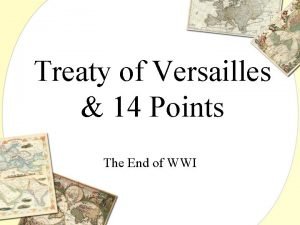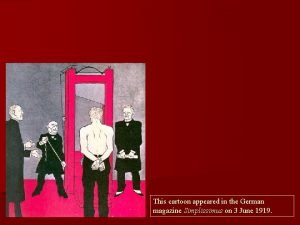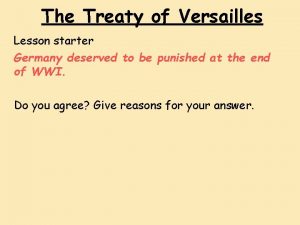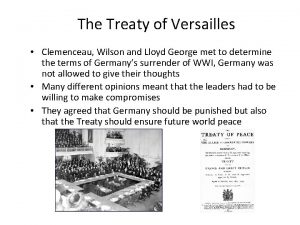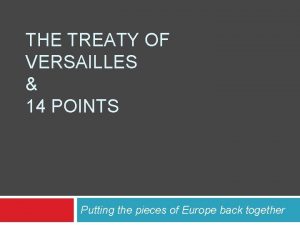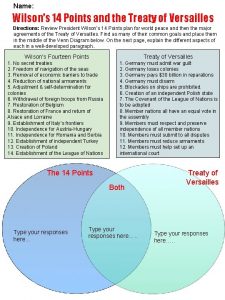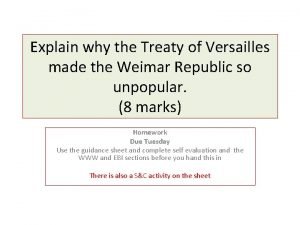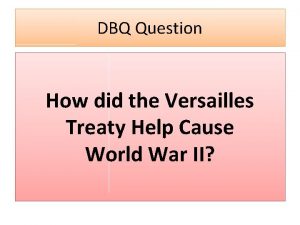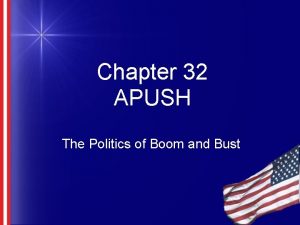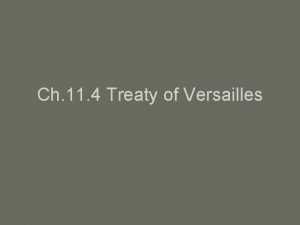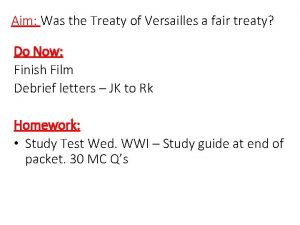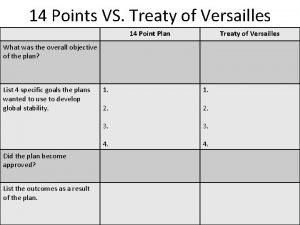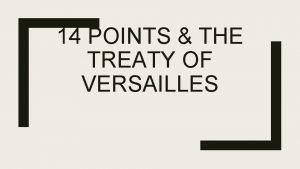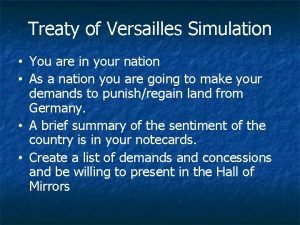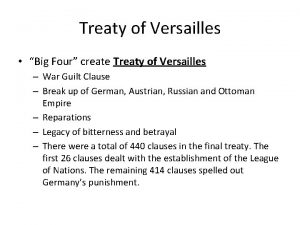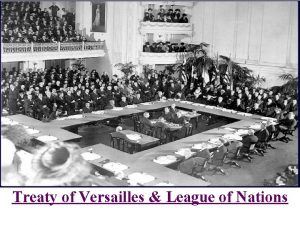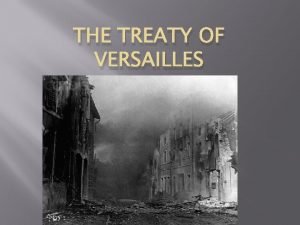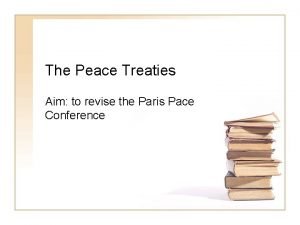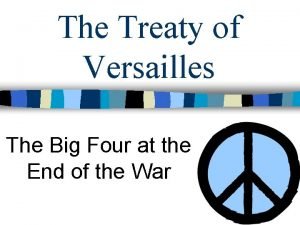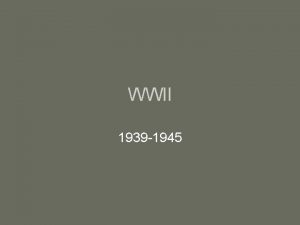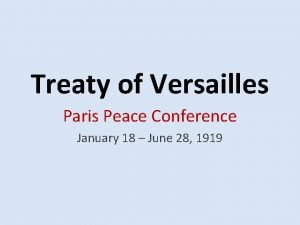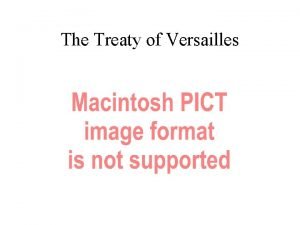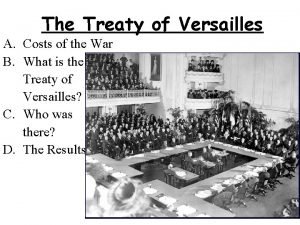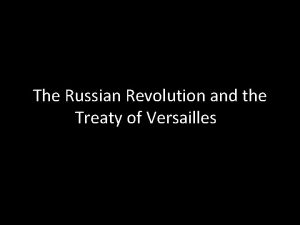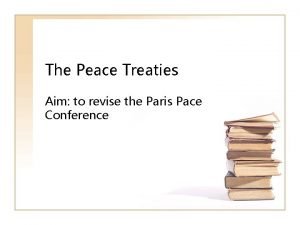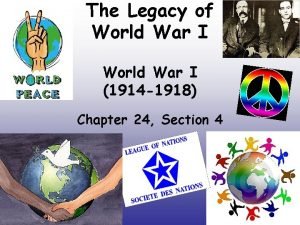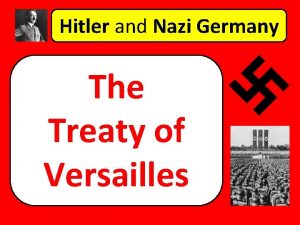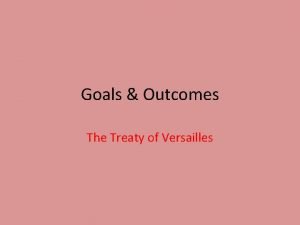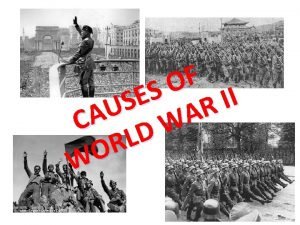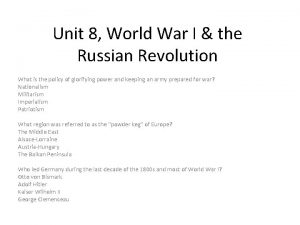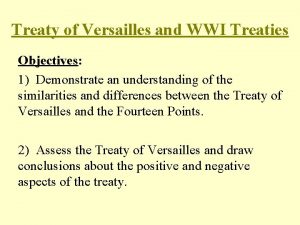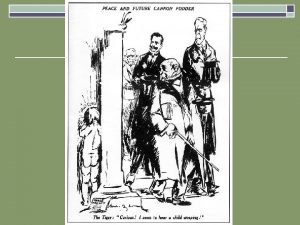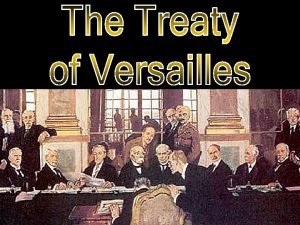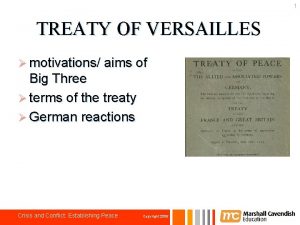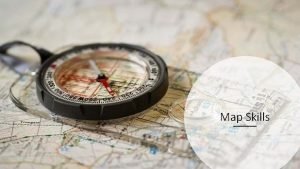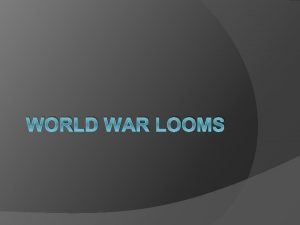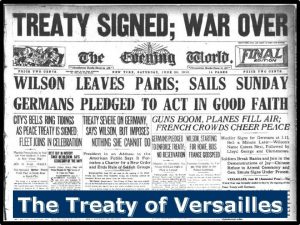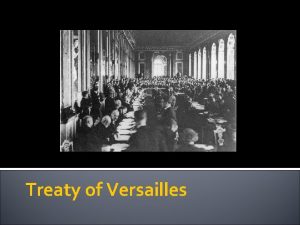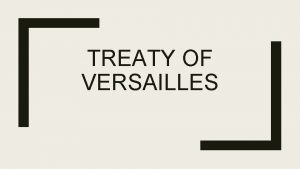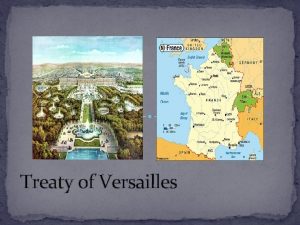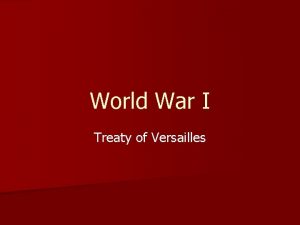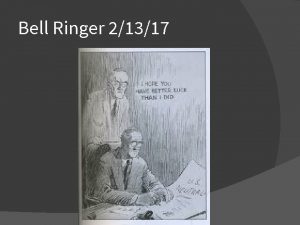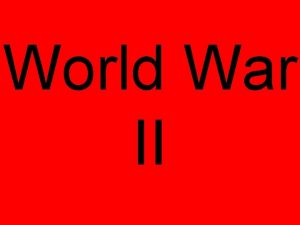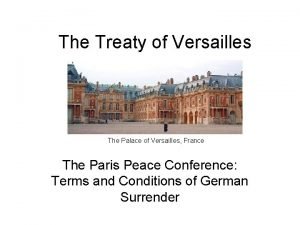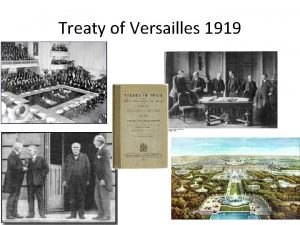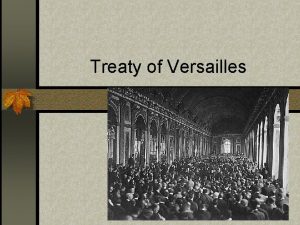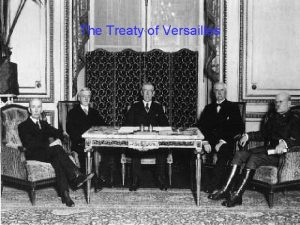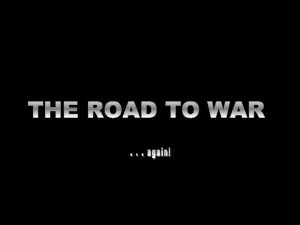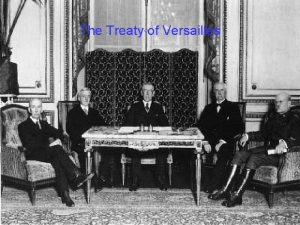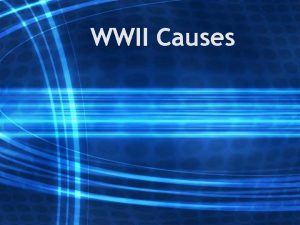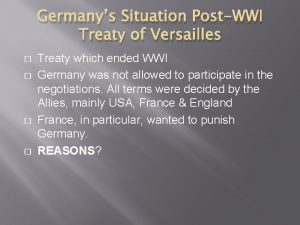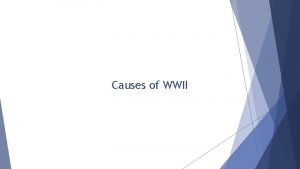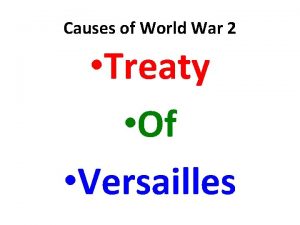World War Looms Chapter Sixteen Treaty of Versailles























































- Slides: 55

World War Looms Chapter Sixteen

Treaty of Versailles League of Nations Territorial Losses Military Restrictions • International peace organization; enemy and neutral nations initially excluded • Germany returns Alsace-Lorraine to France; French border extended to west bank of Rhine River • Limits set on the size of the German army • Germany and Russia excluded • Germany surrenders all of its overseas colonies in Africa and the Pacific • Germany prohibited from importing or manufacturing weapons or war material War Guilt • sole responsibility for the war placed on Germany’s shoulders • Germany forced to pay the Allies $33 billion in reparations over 30 years ** Germany paid off • Germany forbidden the debt on to build or buy October 3, 2010 ** submarines or have an air force

World War Looms Objective Trace the rise of dictators, the beginnings of war, and the American response to the 1930 s

Chapter Overview An imperfect peace leads to the rise of dictators who brutally suppress opponents and innocent people at home and attack their neighbors. Soon the United States is drawn into worldwide war.

Dictators Threaten World Peace Section One

Chapters in Brief The Treaty of Versailles created problems that led to new dangers. Germans resented losing territory and being blamed for starting the war. New democratic governments in many nations were weak. Soon dictators seized power. In the Soviet Union, Joseph Stalin focused on creating a communist state, in which the state takes ownership of farms and factories away from individuals. He also made the nation a huge police state, in which anyone who criticized him or his policies was arrested and removed.

Chapters in Brief In Italy, Benito Mussolini came to power as head of a fascist movement. Fascism combines nationalism with a strong central government, though it avoids communism’s direct control of farms and factories. Mussolini crushed all foes. In Germany, Adolf Hitler hoped to unite all Germanspeaking people into a new German empire. Hitler believed that Germans – especially blond, blue-eyed “Aryans” – were a master race, fated to achieve power over all “inferior races. ” Hitler also believe that Germany had to expand its territory to thrive. His political movement was called Nazism, which combined extreme nationalism with racism and expansionism. Once appointed chancellor, Hitler seized all power.

Chapters in Brief In Japan, military leaders believed that more land resources were needed. In 1931, they launched an attack on a province in China. With success there, Japanese militarists gained control of Japan’s government. The League of Nations’ failure to stop Japan emboldened Hitler and Mussolini. Hitler rebuilt the German armed forces breaking the Versailles treaty. Mussolini conquered Ethiopia in Africa. World nations responded weakly to these threats to peace. Most Americans wanted the U. S. to avoid foreign conflicts. In the Neutrality Acts, Congress outlawed arms sales or loans to nations at war. In 1935, a civil war broke out in Spain between an elected government and a group of fascists. The U. S. government remained neutral. By 1937, Roosevelt was less willing to remain neutral to the dictators’ growing power. When Japan invaded China that year, he continued to send arms and supplies to China.

Nationalism Grips Europe and Asia Less than two decades after the end of WW I – “the war to end all wars” – fighting erupted again in Europe and in Asia Peace had brought not prosperity but revolution fueled by economic depression and struggle Postwar years brought the rise of powerful dictators driven by the belief in nationalism and territorial expansion

Nationalism Grips Europe and Asia (continued) The Treaty of Versailles caused anger and resentment – not “just a secure peace”. Germans saw nothing fair in the treaty 1. blamed for starting the war 2. stripped of overseas colonies and border territories Soviet Union Leader – Joseph Stalin

Nationalism Grips Europe and Asia (continued) Stalin focused on creating a model communist state – specifically agricultural and industrial growth 1937, Soviet Union was the 2 nd largest industrial power – United States still 1 st Stalin was a ruthless dictator 1. did not spare even his most faithful supporters 2. responsible for approximately 8, 000 to 13, 000 deaths 3. millions more died in famines caused by the restructuring of Soviet society Stalin established a totalitarian government – complete control over its citizens

Nationalism Grips Europe and Asia (continued) Italy Leader – Benito Mussolini many issues in Italy: 1. unemployment and inflation produced bitter strikes 2. middle and upper class demanded stronger leadership Mussolini was a powerful speaker who played on the fears of economic collapse and communism Mussolini established the Facist party Fascism stressed nationalism and placed the interests of the state above those of individuals – power must rest with a single strong leader and a small group of devoted party members “Italy wants peace, work, and calm. I will give these things with love if possible, with force if necessary” - Benito Mussolini

Nationalism Grips Europe and Asia (continued) Germany leader – Adolf Hitler was a jobless soldier who joined a struggling group called the National Socialist German Worker’s Party (the Nazi Party) in 1919 – no ties to socialism Nazism – the German brand of fascism based on extreme nationalism Speaking and organizing ability led him to become the party leader – self proclaimed “Der Fuhrer” which means “the leader”

Nationalism Grips Europe and Asia (continued) Hitler wrote Mein Kampf (My Struggle) where it set forth the basic beliefs of Nazism = became the plan of action for the Nazi party enforced racial “purification” – master Aryan race inferior races were deemed fit only to serve the Aryans believed Germans needed more lebenstraum (living space) Great Depression helped the Nazis come to power – unemployed joined Hitler’s private army – Storm Troopers (Brown Shirts) 1932 Nazis were the strongest political power 1933 Hitler appointed chancellor (prime minister)

Nationalism Grips Europe and Asia (continued) Hitler dismantled Germany’s democratic Weimer Republic Hitler established the Third Reich (Third German Empire) Japan leaders agreed with Hitler’s belief in the need for more living space for a growing population League of Nations did nothing when Japan seized Manchuria (Chinese providence)

United States Responds Cautiously Kellogg-Briand Pact that was previously signed to declare war not be used “as an instrument of national policy” did not include a plan to deal with countries that broke their pledge Americans cling to isolationism FDR reached out to the world in several ways and by 1935 Congress passed a series of Neutrality Acts Roosevelt found it impossible to remain neutral; however, the conflict remained “over there”

Essential Question Which type of government, that arose prior to World War II, was the most dangerous? Explain. (Totalitarianism / Fascism / Nazism)

War in Europe Section Two

Chapters in Brief In Europe, Hitler continued plans to increase German power. In 1937, Germany annexed Austria. The next year, Hitler claimed that Germans living in an area of Czechoslovakia were being mistreated. Great Britain and France appeased Hitler by letting him take over this area. Hitler promised it would be his last land seizure. The next year, Hitler claimed persecution of Germans in Poland. Many people thought he would never attack Poland for fear of the Soviet Union, on Poland’s eastern border. Then Germany and the Soviet Union signed an agreement not to attack each other.

Chapters in Brief On September 1, 1939, Hitler launched World War II by attacking Poland. The Germans used tanks and plans in an attack called blitzkrieg, or “lightening war. ” They overran Poland quickly. Great Britain and France declared war on Germany. For the next few months, both sides prepared for war. Meanwhile, Stalin seized some Baltic states and then occupied Finland. In the spring of 1940, Hitler attacked and captured Denmark, Norway, the Netherlands, Belgium, and Luxembourg. His forces overran France. Only Great Britain was left uninvaded. However, Hitler’s air force bombed Britain frequently. The Royal Air Force, though, destroyed many German planes and won the Battle of Britain.


To avoid another world war

To avoid another world war The Pact was dishonorable and would NOT prevent war

To avoid another world war The Pact was dishonorable and would NOT prevent war Not to fight each other; to divide Poland between them

To avoid another world war The Pact was dishonorable and would NOT prevent war Not to fight each other; to divide Poland between them Poland was divided between Germany and the USSR; Britain and France declared war on Germany

To avoid another world war The Pact was dishonorable and would NOT prevent war Not to fight each other; to divide Poland between them Poland was divided between Germany and the USSR; Britain and France declared war on Germany occupied the northern part of France; a Nazi-controlled puppet government was set up in Vichy in southern France

To avoid another world war The Pact was dishonorable and would NOT prevent war Not to fight each other; to divide Poland between them Poland was divided between Germany and the USSR; Britain and France declared war on Germany occupied the northern part of France; a Nazi-controlled puppet government was set up in Vichy in southern France “Air War; ” a British victory forced Hitler to call off the invasion of Britain indefinitely

The Holocaust “Work Sets You Free” Section Three

Chapters in Brief Part of Hitler’s plan for Germany was to make the country racially pure. In 1933, he ordered all non-Aryans out of government jobs. In 1935, new laws hurt the people who were Hitler’s main target: the Jews. They lost their civil rights and property. In 1938, the Nazis terrorized Jews in a night of attacks. During the Nazis’ rise to power, Jews left Germany in great numbers. The United States accepted some 100, 000 refugees, but refused to accept more. Many Americans feared competition for scarce Depression -era jobs. In 1939, the Nazis adopted a horrible “final solution” to what they called “the Jewish problem, ” Jews who were healthy would be seized and sent to slave labor camps. The rest would be taken and systematically killed. Some Jews were crowded into ghettos, special sections of cities. Most were taken to concentration camps where they suffered hunger, illness, overwork, and death. In 1941, the Nazis built special “death camps” meant solely to kill people in mass numbers. Prisoners were gassed or shot. Some died in horrible medical “experiments. ” Nearly six million Jews died in the death camps. The Nazis also murdered many other peoples: Soviets, Poles, gypsies, homosexuals, and the disabled. Remarkably, some survived to tell the world of the atrocity.


Long history of anti-Semitism (prejudice against Jews))

Long history of anti-Semitism (prejudice against Jews) Stripped Jews of their Civil Rights and property if they tried to leave Germany; Over age 6 must wear ID symbol (Yellow Star of David)

Long history of anti-Semitism (prejudice against Jews) Stripped Jews of their Civil Rights and property if they tried to leave Germany; Over age 6 must wear ID symbol (Yellow Star of David) Gangs of Nazi storm troopers attacked Jewish homes, businesses, and temples

Long history of anti-Semitism (prejudice against Jews) Stripped Jews of their Civil Rights and property if they tried to leave Germany; Over age 6 must wear ID symbol (Yellow Star of David) Gangs of Nazi storm troopers attacked Jewish homes, businesses, and temples Anti-Semitism, Great Depression, Fear of “enemy agents”

Long history of anti-Semitism (prejudice against Jews) Stripped Jews of their Civil Rights and property if they tried to leave Germany; Over age 6 must wear ID symbol(Yellow Star of David) Gangs of Nazi storm troopers attacked Jewish homes, businesses, and temples Anti-Semitism, Great Depression, Fear of “enemy agents” Jews, Communists, gypsies, homosexuals, mentally disabled, Poles, Ukrainians, Russians

Long history of anti-Semitism (prejudice against Jews) Stripped Jews of their Civil Rights and property if they tried to leave Germany; Over age 6 must wear ID symbol (Yellow Star of David) Gangs of Nazi storm troopers attacked Jewish homes, businesses, and temples Anti-Semitism, Great Depression, Fear of “enemy agents” Jews, Communists, gypsies, homosexuals, mentally disabled, Poles, Ukrainians, Russians Created large, factory-like Death camps. Used poison gas as well as more traditional forms of killing

AMERICA MOVES TOWARD WAR SECTION FOUR From a nation of neutrality to a nation of nuclear bombs

Chapters in Brief According to the Neutrality Acts, the United States could not enter the war in Europe to aid Poland after Germany invaded Poland. However, President Roosevelt began preparing the nation for war. He persuaded Congress to amend the acts, allowing the United States to sell weapons to Great Britain and France. When Japan signed an agreement with Germany and Italy, many Americans were alarmed. Roosevelt increased the aid to Great Britain. At the same time, Congress passed a military draft and began training men for the armed forces. In 1940, Roosevelt broke tradition and ran for a third term as president. He won. Roosevelt spoke to Americans of the threat Hitler posed. He proposed increasing American armaments to loan to Great Britain. He stopped short of entering the war. Some aid went to the Soviet Union too: Hitler had broken his agreement with Stalin in 1941 and attacked his former ally. The Germans used submarines to attack the American ships carrying weapons and

Chapters in Brief In August 1941, Roosevelt met with British Prime Minister Winston Churchill. They issued the Atlantic Charter, a statement of goals for which the war was being fought. The United States had not yet entered the war, however. German submarines attacked American ships, but Roosevelt felt he lacked support to declare war. In the Pacific, conflict grew between Japan and the United States. When Japan seized Indochina, the United States protested. Peace talks between the two countries began in late 1941. On December 7, 1941, however, the Japanese attacked the main U. S. naval base at Pearl Harbor, Hawaii. The attack left many navy ships destroyed and others crippled. The next day, President Roosevelt asked Congress for a declaration of war, which was quickly approved.

United States Musters Its Forces In 1939, the Germans invaded Poland During this time Roosevelt revised the Neutrality Act of 1935 and prepared the nation for the struggle that lay ahead 1939 Roosevelt persuaded congress to pass a “cash-and-carry” – provision allowing warring nations to buy U. S. arms as long as they paid cash, and transported them in their own ships Congress passed the Neutrality Act of 1939 and the cash-and-carry policy went into effect

The Axis Threat By summer of 1940, France had fallen and Britain was under siege Roosevelt sent aid to the British rifles and machine guns On September 27, 1940 Germany, Italy, and Japan had signed a mutual defense treaty Tripartite Act -designed to keep the United States out of the war Axis Powers Germany, Italy, and Japan

Building Defenses Roosevelt asked Congress to increase spending for National Defense 1940 Congress passed the first peacetime military draft 16 million men between the ages of 21 and 35 were registered

Great Arsenal of Democracy Britain had spent all of their money Lend-Lease Policy the president would lend or lease arms and other supplies to “any country whose defense was vital to the United States” Congress passed the Lend Lease Act in March 1941 U. S. not only helped Britain, but helped the Soviet Union as well

Great Arsenal of Democracy Lend-lease act was to aid Britain and the Soviet Union, and to ensure the safe delivery of goods to the countries Hitler deployed hundreds of U-boats to sink ships bringing supplies to Britain and the Soviet Union 1941 - Roosevelt granted the Navy permission for U. S.

FDR’s Plans for War Churchill and Roosevelt created a joint declaration of arms Atlantic Charter a 1941 declaration of principles in which the United States and Great Britain set forth their goals in fighting the Axis Powers = Makes Britain and U. S. ALLIES Allies The nations who fought against the Axis powers: United States, Britain, Soviet Union (China, Mexico, Brazil, and numerous others)

Japan Attacks the United States French, Dutch, and British colonies in the area were unprotected the British were too busy fighting off Hitler to protect their colonies only the U. S. and its Pacific Islands were in Japan’s way Japan’s leader - Hideki Tojo (becomes prime minister)

Pearl Harbor

Japan Attacks the United States ** Attack on Pearl Harbor Video

Pearl Harbor Attack U. S. military leaders had known from a coded Japanese message that an attack might come did NOT know when or where Damages in about two hours 1. 19 ships including 8 battleships 2. approximately 2, 403 killed 3. approximately 1, 178 wounded Good News: all aircraft carriers were in the ocean On December 7, 1941 the Japanese bombed the naval base at Pearl Harbor in Hawaii “The Day That Will Live in Infamy”

Pearl Harbor from the Cockpit of a Japanese Pilot

Pearl Harbor - Dec. 7, 1941 “A date which will live in infamy!”

USS Arizona, Pearl Harbor

President Roosevelt Signs the US Declaration of War on December 8, 1941

Essential Question Do you think the United States should have waited to be attacked before declaring war? Justify your answer. Answer the question in three complete sentences in your summary section

World War Looms Objective Trace the rise of dictators, the beginnings of war, and the American response to the 1930 s
 Building vocabulary world war looms
Building vocabulary world war looms Chapter 16 building vocabulary world war looms
Chapter 16 building vocabulary world war looms Chapter 24 world war looms section 1 answers
Chapter 24 world war looms section 1 answers Dictators threaten world peace chapter 24 section 1 answers
Dictators threaten world peace chapter 24 section 1 answers Chapter 16 building vocabulary world war looms
Chapter 16 building vocabulary world war looms Chapter 16 section 1 dictators threaten world peace
Chapter 16 section 1 dictators threaten world peace Chapter 16 world war looms answer key
Chapter 16 world war looms answer key Chapter 24 world war looms
Chapter 24 world war looms Chapter 24 world war looms
Chapter 24 world war looms Chapter 24 world war looms
Chapter 24 world war looms Comparing the 14 points & treaty of versailles
Comparing the 14 points & treaty of versailles Treaty of versailles the big three
Treaty of versailles the big three Treaty of versailles 1815
Treaty of versailles 1815 Article 231 of the treaty of versailles
Article 231 of the treaty of versailles Peace and future cannon fodder cartoon meaning
Peace and future cannon fodder cartoon meaning Pptpalooza
Pptpalooza Simplissimus 3 june 1919
Simplissimus 3 june 1919 Whats treaty of versailles
Whats treaty of versailles Whats treaty of versailles
Whats treaty of versailles Trawl treaty of versailles
Trawl treaty of versailles 14 points vs treaty of versailles
14 points vs treaty of versailles Wilson's 14 points vs treaty of versailles venn diagram
Wilson's 14 points vs treaty of versailles venn diagram Treaty of versailles lamb
Treaty of versailles lamb How did the versailles treaty help cause ww2
How did the versailles treaty help cause ww2 Time in germany
Time in germany Treaty of versailles apush def
Treaty of versailles apush def Wilson's fourteen points and the treaty of versailles
Wilson's fourteen points and the treaty of versailles 14 points compared to the treaty of versailles
14 points compared to the treaty of versailles 14 point plan vs treaty of versailles
14 point plan vs treaty of versailles Treaty of versailles 14 points
Treaty of versailles 14 points Treaty of versailles
Treaty of versailles Site:slidetodoc.com
Site:slidetodoc.com The big 4 and the treaty of versailles interactive notebook
The big 4 and the treaty of versailles interactive notebook Treaty of versailles middle east
Treaty of versailles middle east Big four paris
Big four paris Treaty of versailles gargle
Treaty of versailles gargle The big 4 and the treaty of versailles
The big 4 and the treaty of versailles What year was the treaty of versailles signed
What year was the treaty of versailles signed What year was the treaty of versailles signed
What year was the treaty of versailles signed The treaty of versailles
The treaty of versailles Us and the treaty of versailles
Us and the treaty of versailles The treaty of versailles
The treaty of versailles Treaty of versailles terms
Treaty of versailles terms Treaty of versailles pictures
Treaty of versailles pictures Treaty of versailles sanhi at bunga
Treaty of versailles sanhi at bunga Treaty of versailles gargle
Treaty of versailles gargle Europe map
Europe map The treaty of versailles
The treaty of versailles Louis xiv goals
Louis xiv goals Treaty of versailles terms
Treaty of versailles terms How did the treaty of versailles affect postwar germany
How did the treaty of versailles affect postwar germany Fourteen points and treaty of versailles similarities
Fourteen points and treaty of versailles similarities 0
0 B.r.a.t treaty of versailles
B.r.a.t treaty of versailles Georges clemenceau treaty of versailles aims
Georges clemenceau treaty of versailles aims 16 compass points
16 compass points
